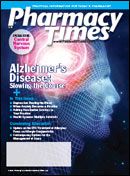Publication
Article
Pharmacy Times
Counseling Patients on Their OTC Treatment Options
Author(s):
Pharmacists are the "go to" source for patients seeking advice on their OTC options.
Dr. Coleman is an assistant professorof pharmacy practice and director ofthe pharmacoeconomics and outcomesstudies group at the University ofConnecticut School of Pharmacy.
Increasingly, pharmacies are becominga destination for patientslooking for health care servicesand advice-not only on the myriadRx and OTC medications, butalso on ways to prevent illnessand promote better health.
Test your clinical skills withthese cases featuring topics patientsfrequently ask about.
Constipation

The pharmacist at the local independentpharmacy notices SB, a 52-year-oldwoman in the laxative aisle readingthe back of boxes and realizes thatthis is a good opportunity to do somepatient counseling. Upon questioning,SB explains to the pharmacist that shehas been having infrequent bowel movementsfor the past 2 weeks and nowis suffering from abdominal discomfort,bloating, and a feeling of fullness.SB notes no important changes in herhealth but mentions that she started takingdiphenhydramine a few weeks backbecause of her seasonal allergies. Whatother questions should the pharmacistask SB? What should the pharmacistrecommend for SB's constipation?
The pharmacist should ask SB whetherher diet contains enough crude fiber(>10 g/day) from fruits, vegetables,and cereals. This level of intake is oftensufficient to prevent constipation inthe majority of patients, but it maytake as long as 1 month to work. Theinfrequent use of laxatives (less thanevery few weeks) is typically acceptable,but bulk-forming agents shouldbe tried first. If ineffective, sennosides,bisacodyl, or saline laxatives can betried. SB should be counseled that if alaxative is required for longer than 1week, she should consult her physician.Because the anticholinergic effects ofdiphenhydramine could be contributingto her constipation, SB may wantto contact her doctor if her seasonalallergies are troublesome to get a seasonalallergy therapy that will notcontribute to her constipation, such asa nasal steroid.
Cold Sores

HS, a 23-year-old man comes to the pharmacyand after stopping in the naturalproducts aisle, walks to the counter witha bottle of L-lysine capsules, and asks totalk with the pharmacist. HS reveals thathe is a lifeguard at a local beach and suffersfrom frequent cold sores during thesummer. HS says he knows that a coldsore is coming when he feels a tinglingand burning sensation near the edge ofhis lip. He notes that he is feeling thesesymptoms now and is hoping that, if heacts quickly, the cold sore will not beas bad. HS claims a friend told him thatL-lysine can help with cold sores. Hewants to know if it really works. Whatshould the pharmacist tell HS?
The pharmacist should inform HSthat, according to the FDA, neitherL-lysine nor any other oral OTC medicationare effective in curing coldsores, but that typically cold soresresolve on their own within 7 to 10days. The pharmacist could recommendHS apply docosanol 10% to thetingling site. BecauseHS's cold soreis still in the "prodrome" (presore)stage, administration of docosanolmay decrease its duration and reducesymptoms. If a cold sore appearsand is painful, the pharmacist couldrecommend HS try acetaminophen oribuprofen as well as a topical anestheticagent (such as benzocaine).Additional recommendations mightincludekeeping the site clean andapplying petroleumjelly to the coldsore to prevent cracking and subsequentinfection. Perhaps most importantly,HS should use sunscreen inthe future, as cold sores are commonlytriggered by sun exposure.
Head Lice

PC is a 32-year-old mother of twin,10-year-old girls. She comes into thepharmacy with a distraught look andproceeds to tell the pharmacist that shehas just received a call from the schoolnurse asking her to come and pick upone of the girls, who-after a routinehead check-was found to have headlice. She proclaims how embarrassedshe is about the situation and swearsthat "her girls aren't dirty." How shouldthe pharmacist handle this situation?
The pharmacist should reassure PCthat head lice (Pediculus capitis) is acommon problem in school childrenup to 12 years of age and is not relatedto poor hygiene and then advise PCto wash hairbrushes, combs, toys,cloths, linens, and towels in hot water.Items that cannot be washed shouldbe thrown away or sealed in a plasticbag for 2 weeks. PC can choose from avariety of OTC treatment options forher daughter. These include productscontaining pyrethrin or permethrin,as well as therapies that are pesticidefree,such as dimethicone. PC shoulduse the products as directed alongwith a nit comb. If lice persist after2 courses of therapy or after 2 weeks,PC should call her daughter's pediatrician.PC's other daughter was notfound to have head lice; therefore,she does not need to be treated, butall members of the family should bechecked periodically.
Acne

AV, a 14-year-old girl, comes into thepharmacy looking sad. The pharmacistnotices 5 or so mild acne lesions on herface. She tells him that her junior highschool prom is in a little more than amonth, and she is worried about hercomplexion. She wants to get an OTCproduct to treat her current acne lesionsand prevent future breakouts, but isafraid that such a product will dry outher skin. What should the pharmacistrecommend?
Benzoyl peroxide creams, lotions,gels, and soaps are effective OTC treatmentsfor AV's mild acne. Benzoylperoxide is broken down on the skin,producing oxygen-free radicals, killingbacteria (Propionibacterium acnes),and causing epithelia skin cells of theacne lesions to slough off. The pharmacistmight recommend that AV usea benzoyl peroxide product that doesnot contain alcohol (because these areless likely to cause skin to dry out) ata lower potency-2.5%. The concentrationcould then be titrated up to5% or 10% as needed. Alternatively,the frequency of administration couldbe increased from every other day todaily and to twice daily to get optimalresults while minimizing the riskof drying or irritating skin. Benzoylperoxide also should not be applied tomoist skin, because this will increasethe risk of her skin drying out. It isimportant that she wait at least onehalf hour after washing her face.







